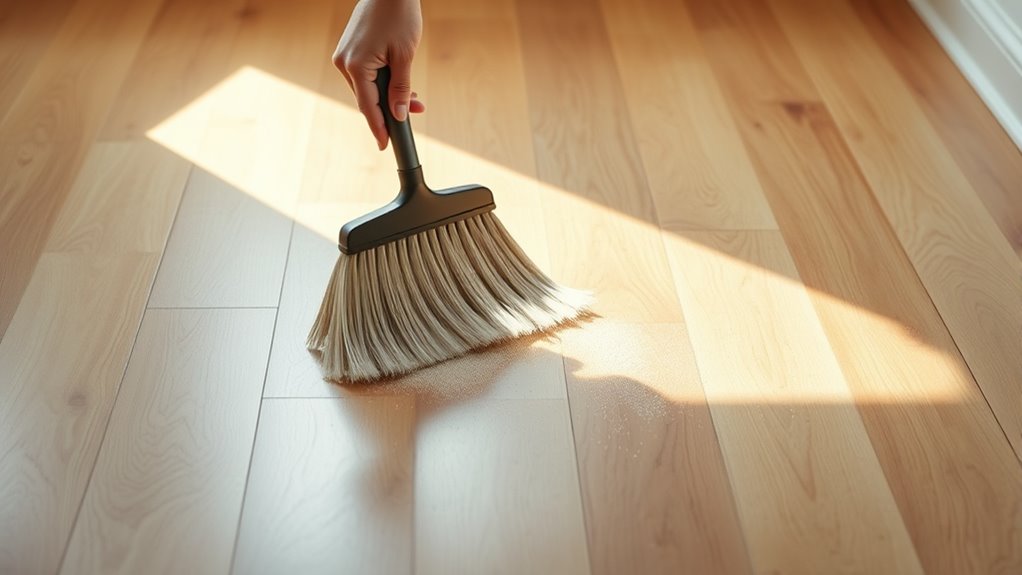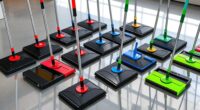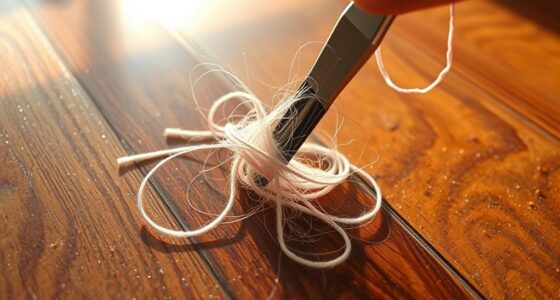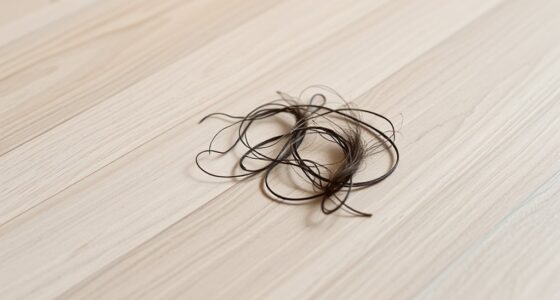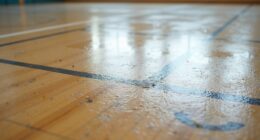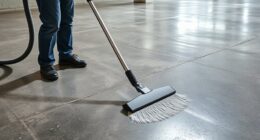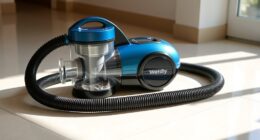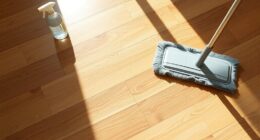To beat fine dust on your hardwood floors, start with a first pass using a soft-bristled broom along the grain to gather larger debris. Follow with a microfiber cloth or damp mop to trap the finer particles missed initially. Using an air purifier during and after cleaning helps reduce airborne dust. Repeating this two-pass approach regularly keeps your floors cleaner and healthier. Keep going for more tips to maintain pristine hardwood surfaces here.
Key Takeaways
- Use an air purifier beforehand to reduce airborne dust and improve sweeping effectiveness.
- Sweep along the wood grain with a soft-bristled broom to loosen surface dust without scratches.
- Follow with a microfiber cloth or damp mop to trap and lift remaining microscopic dust particles.
- Repeat the two-pass process regularly to prevent dust buildup and maintain floor cleanliness.
- Wear protective gear and keep air purifiers running to enhance health and indoor air quality during cleaning.
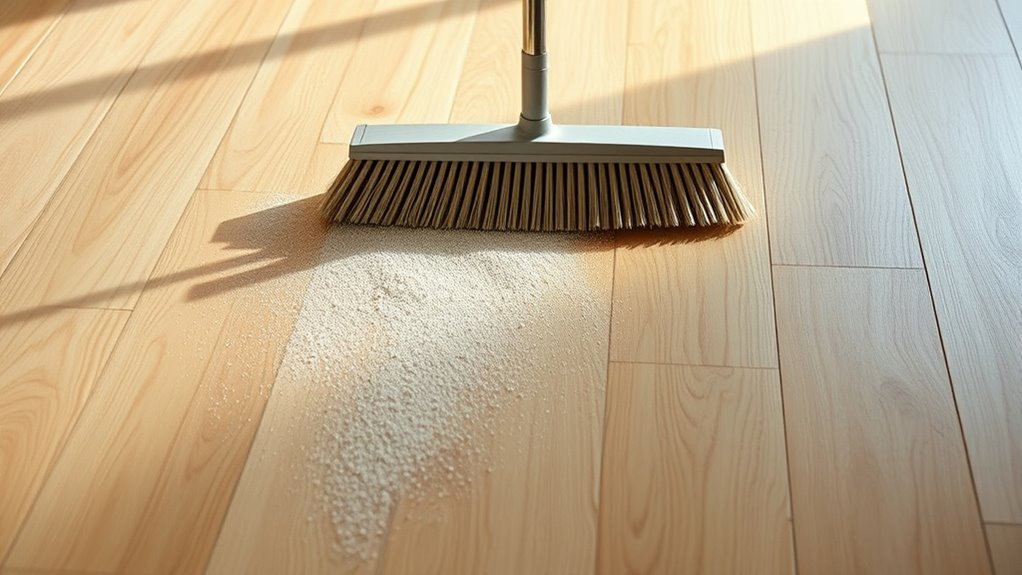
Fine dust can quickly accumulate on hardwood floors, making your space look dirty and affecting indoor air quality. This tiny debris settles into every corner, sneaks into carpets, and often lingers in the air, creating a constant need for effective cleaning. To truly beat fine dust, you need a strategic approach that combines proper cleaning tools with good habits. A two-pass sweeping plan can be highly effective, but it’s essential to do it right.
Start by preparing your space with the right tools. Before sweeping, consider using an air purifier in the room. An air purifier helps to reduce airborne dust particles, so when you sweep, you’re working in a cleaner environment. It also prevents dust from settling again immediately after cleaning, prolonging the freshness of your space. Wearing protective gear, such as a mask and gloves, can prevent you from inhaling or coming into direct contact with dust particles. While it may seem excessive, protecting yourself guarantees your health isn’t compromised, especially if your home experiences heavy dust buildup or allergies.
The first pass of sweeping is straightforward but vital. Use a soft-bristled broom designed for hardwood floors. Sweep along the grain of the wood to lift dust without scratching the surface. Cover the entire area methodically, paying special attention to corners, edges, and under furniture where dust tends to settle. This initial sweep loosens and gathers the bulk of the dust, but it’s unlikely to pick up every microscopic particle. After this, don’t just stop—your second pass is where the real cleaning happens.
For the second pass, switch to a microfiber cloth or a slightly damp mop. Microfiber is excellent at trapping dust and fine particles that the broom might miss. Run this cloth or mop over the same areas, focusing on lifting the remaining dust and dirt. This step not only cleans more thoroughly but also leaves your hardwood floors looking polished and fresh. If you notice stubborn spots or embedded dust, repeat the process or use a dedicated hardwood floor cleaner for extra effectiveness.
Throughout this process, keep your air purifier running. It will continuously filter out airborne dust, making your overall cleaning more efficient. Wearing protective gear isn’t just about safety; it’s about guaranteeing you don’t reintroduce dust into your lungs or onto your clothes. By combining this two-pass sweeping plan with protective gear and an air purifier, you create a cleaner, healthier environment. Regularly repeating these steps keeps fine dust at bay, preserving the beauty of your hardwood floors and improving your indoor air quality. Utilizing proper cleaning tools ensures you remove dust effectively and maintain your floors’ appearance over time.
Frequently Asked Questions
Can I Use a Regular Broom Instead of a Soft-Bristled One?
You can use a regular broom instead of a soft-bristled one, but it’s not ideal. Regular brooms with stiff bristles may scratch your hardwood or push dust around rather than pick it up. For better results, choose a broom with soft bristles suited for delicate surfaces. Clean your floors frequently, especially if you notice dust accumulation, to keep your hardwood looking its best without causing damage.
How Often Should I Perform the Two-Pass Sweeping Plan?
Think of dust accumulation as a quiet tide creeping in; you should perform the two-pass sweeping plan at least twice a week. Regular cleaning keeps fine dust from settling into your hardwood floors and maintains their shine. If you notice more dust or debris, increase your cleaning frequency. Consistent sweeping not only preserves your floors but also creates a healthier environment, making dust buildup less of a persistent problem.
Is It Safe to Use Water-Based Cleaning Solutions on Hardwood Floors?
Yes, using water-based solutions on hardwood floors is generally safe if you follow proper cleaning safety. Make sure to use a damp mop, not soaking wet, to prevent water damage or warping. Check the product label for compatibility with your floor’s finish, and avoid harsh chemicals. Properly diluted water-based solutions provide effective cleaning without harming the wood, keeping your floors looking great and safe for everyday use.
What Type of Dust Mop Is Best for Fine Dust Removal?
Think of your dust mop as a magnet for fine dust. The best dust mop types for this job are flat microfiber mops, which are made of soft microfiber materials. Microfiber dust mops trap tiny particles effectively without scratching your hardwood. Choose a lightweight, flat design for easy maneuvering and better dust pickup. Regularly wash the microfiber to keep it performing like new and guarantee your floors stay dust-free.
Can I Incorporate Vacuuming Into the Two-Pass Sweeping Plan?
Yes, you can incorporate vacuuming into your two-pass sweeping plan. Vacuuming benefits include better dust containment and removal of fine dust particles that sweeping might miss. Start with a thorough vacuuming to pick up loose dust and debris, then follow with sweeping to catch any remaining fine dust. This combination guarantees a cleaner hardwood floor, reduces allergens, and maintains a healthier environment.
Conclusion
With this two-pass sweeping plan, you’re like a skilled artist wiping away the dust that tries to hide your hardwood’s true beauty. Each sweep is a stroke of perfection, revealing a floor so gleaming it mirrors your pride. Say goodbye to stubborn particles and hello to a surface that feels as fresh as a morning breeze. Keep up this routine, and your floors will stay dazzling, turning every step into a dance on polished perfection.
